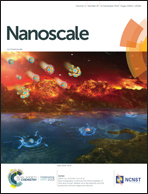N-Doped yolk–shell carbon nanotube composite for enhanced electrochemical performance in a supercapacitor†
Abstract
Carbon nanotubes (CNTs) have been intensively studied as electrode materials in supercapacitors due to their unique tubular structure, high mechanical strength, and excellent conductivity. However, the low surface area, poor pore distribution and inert surface severely limit their electrochemical performance. Herein, a process of co-assembly of CNTs with 1-cetyl-3-methylimidazolium bromide ([C16Mim]Br), tetraethoxysilane and resorcinol/formaldehyde resin (RF) is used to prepare a series of composites of CNTs with mesoporous carbon (MC/CNT). The amount of CNTs used strongly affects the structures of the MC/CNT composite, in which the composite structure is adjusted from yolk–shell CNTs combined with folded MC spheres to uniform yolk–shell CNTs, and then to CNTs with uniformly located irregular carbon fragments. The use of [C16Mim]Br effectively assists the assembly of the RF/silica hybrid on the CNTs due to the electrostatic interaction among them, and this also leads to N-doping in the MC/CNT composite. The existence of MC provides uniform mesopores and increases the surface area of the composite materials, offers rich active sites, and at the same time, the CNTs supply sp2-hybridized carbon which benefits the conductivity. As the electrode material in the supercapacitor, MC/CNT with a uniform yolk–shell structure shows high electrochemical performance, demonstrating its excellent promise for energy storage applications.



 Please wait while we load your content...
Please wait while we load your content...